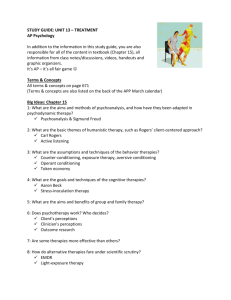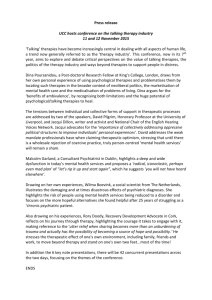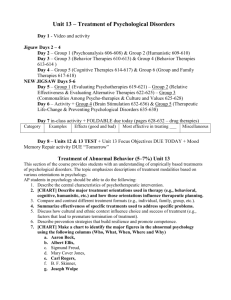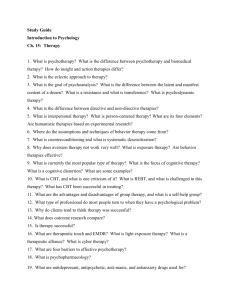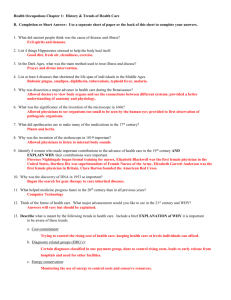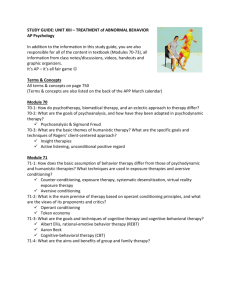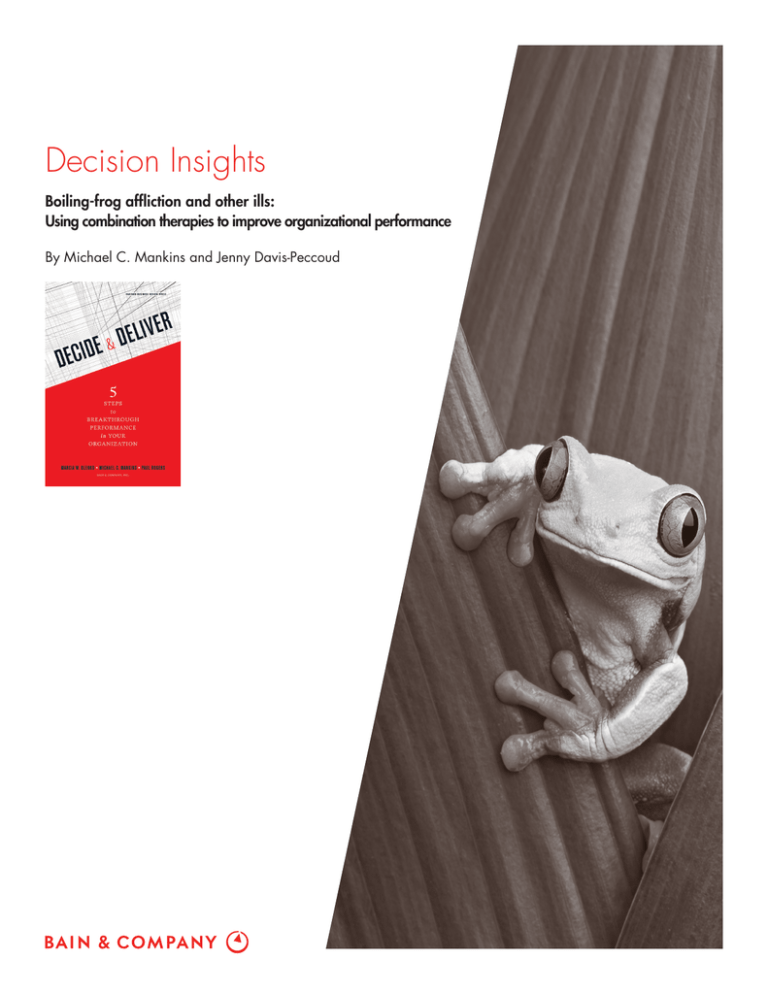
Decision Insights
Boiling-frog affliction and other ills:
Using combination therapies to improve organizational performance
By Michael C. Mankins and Jenny Davis-Peccoud
Michael C. Mankins leads Bain’s Organization practice in the Americas and
is a senior member of Bain’s Global Strategy practice. He is a partner in the
firm’s San Francisco office. Jenny Davis-Peccoud leads Bain’s Organization
practice in Europe, the Middle East and Africa. She is based in London.
The authors would like to thank Cornelia de Ruiter, senior practice consultant
for Bain’s Global Organization practice, for her support with this article.
Copyright © 2013 Bain & Company, Inc. All rights reserved.
Boiling-frog affliction and other ills
Companies trying to fix an underperforming organization typically try first one remedy and then another,
hoping to find something that will work. But organizations are complex, and their problems rarely respond
to a single solution. The most effective treatments usually
involve several different therapies at once.
pursued “combination therapies,” addressing multiple
dimensions at once (see Figure 1).
The results? Single-dimension therapies typically didn’t
work. A poor structure, for example, is rarely the root
cause of poor business performance. And even when
structure does get in the way, as it did in some of the
cases we studied, a reorganization alone is seldom sufficient to turn things around. It’s much the same with
people, processes, decision accountabilities and the
other elements of an organization: You usually need
to fix more than one. In fact, in more than 85% of the
cases we examined, successful treatment of organizational underperformance required some form of
targeted combination therapy (see Figures 2 and 3).
A company’s first job, of course, is to diagnose where
and how its organization is failing, thereby narrowing
the treatment options. To help in the process, we studied
the trajectories of more than 1,000 organizations between
2006 and 2012. The research identified five common
clusters of ailments, all of which undermined financial
performance and employee engagement in one way
or another ( see the sidebar, “Diagnosing sick
organizations”).
A case in point is Ford Motor Company. When Alan
Mulally became CEO of the company in 2006, Ford
was losing market share and its finances were shaky.
It had too many unrelated brands, too little commonality
across its models, too many financially troubled suppliers
(continued on page 4)
We then created a set of 164 before-and-after cases,
looking at what companies had done to address their
organizational ills and the ultimate results. Some
companies had tried single-dimension therapies—fixing
an inadequate structure, for instance—while others
Figure 1: Combination therapies address multiple organizational dimensions, mono therapies just one
100%
9 dimensions
Performance
Alignment
8 dimensions
Leadership
7 dimensions
Clarity
60
6 dimensions
People
40
5 dimensions
20
4 dimensions
80
10 dimensions
Roles
Structure
3 dimensions
0
2 dimensions
Combination therapies:
Number of organizational dimensions addressed
Mono therapies:
Type of organizational dimension addressed
Source: Bain internal survey, May 2013 (n=164)
1
Boiling-frog affliction and other ills
Figure 2: The success rate of combination therapies is far higher than the success rate of mono therapies
Performance impact of organizational initiatives
Impact on organizational performance for combination vs. mono therapies
100%
Low/negative impact
80
Moderate-performance impact
60
40
20
High-performance impact
0
Mono
Combination
Score 9-10: Strong, positive impact on performance,
making initiative worth the risk, cost and effort
Score 0-6: Low or no positive
impact/destruction of value
Score 7-8: Positive impact on performance,
worth the cost but not transformational
Combination therapies have a significantly higher success rate, with about 85% having a positive impact.
Of this group, about 40% drive a step change in performance, vs. only 3% for single-factor therapies.
Source: Bain internal survey, May 2013 (n=164)
Figure 3: Impacts vary depending on how many—and which—organizational dimensions are addressed
Combination therapies
Mono therapies
High
Results impact score
High
Results impact score
Moderate
Low/negative
4
3
2
Number of organizational dimensions addressed
Type of dimension addressed
Source: Bain internal survey May 2013 (n= 164)
2
Incentives
5
Roles
6
Clarity
7
Leadership
8
People
9
Alignment
10
Mono
therapy
performance
Structure
Low/negative
Moderate
Combination
therapy
performance
Boiling-frog affliction and other ills
Diagnosing sick organizations
Underperforming organizations rarely suffer from a single malady. Analysis of the most troubled companies suggests that ailments tend to come in clusters, with different elements of the organization affected simultaneously (see figure below). That’s why combination therapies are so effective—identifying the relevant
cluster helps determine the right treatment. Here are five major pathologies we found, along with the percentage
of those in the troubled-company subgroup suffering from each one. See if any are infecting your organization:
Boiling-frog affliction (34%): No imminent life-threatening maladies, but many minor issues and
bottlenecks across the organizational system. A company suffering from this common cluster is often
like the proverbial boiling frog, not noticing it is in trouble until the condition is serious.
Drifting disease (29%): Lack of vision and direction, further worsened by talent and leadership challenges—a
common cluster among mature companies that have begun to drift and now require fresh visionary leadership.
Confusion complaint (16%): Lack of alignment and clarity on strategic priorities, creating role uncertainty
and blurred performance objectives. Confusion of this sort is common after a change in leadership or strategy.
Process pathology (12%): Unfit systems, ineffective metrics and duplicative, complex processes, all of
them impairing people’s ability to cooperate effectively. This cluster is common in industries such as
financial services, where rapid growth, globalization and complicated regulations have introduced additional layers of complexity over time.
Fast-growth failure (9%): Malfunctioning hardware, with a misaligned structure, unclear accountabilities
and weak governance system, all undermining employee engagement. Rapidly growing companies may suffer
from some or all of these ills.
Diagnosing sick organizations: The most common clusters of pathologies among underperforming companies
Organizational
dimensions
Boiling-frog
affliction
Drifting
disease
Confusion
complaint
Process
pathology
Fast-growth
failure
Severe Minor Neutral
malady malady
Severe Minor Neutral
malady malady
Severe Minor Neutral
malady malady
Severe Minor Neutral
malady malady
Severe Minor Neutral
malady malady
Clarity
Alignment
Roles
Structure
Processes
Information
People
Incentives
Leadership
Cullture
Source: Bain & Company
3
Boiling-frog affliction and other ills
and dealers, and too much reliance on big SUVs and trucks.
Though Ford had decades of internal analyses and consulting studies documenting these difficulties, the organization seemed unable to address them. Like about 12%
of the organizations in our sample, the company was a
victim of process pathology. It had many talented executives
but lacked good processes and clear decision roles, so it
couldn’t get things done.
Like Ford, the companies in our study that employed
tailored combination therapies to treat their organizational ills showed dramatically better results. In fact,
companies that pursued combination therapies were
12 times as likely to see a step change in performance
as those that relied on rifle-shot therapies.
Structural change and other one-shot remedies appeal
to many executives because they are simple. But those
remedies almost always fall short. Success in addressing
organizational ills requires leaders to diagnose their
organization’s ailments, understand which of the five
pathology clusters are most prevalent in their company
and then employ targeted combination therapies. As
the case of Ford suggests, such an approach can produce
remarkable results.
Mulally recognized that Ford’s situation required multiple therapies. He started by reorganizing the company,
moving from a regional business unit structure (which
discouraged common global platforms) to a global matrix.
Equally important, his team created a process—weekly
business plan review meetings—for making key decisions, and clarified the roles executives would play in
each one. A simple system of color-coded charts ensured
that senior leaders had an accurate view of which decisions were on track and which were running into
obstacles. Soon Ford was on the move. It divested or
eliminated brands and reduced the number of vehicle
platforms. It accelerated the development of new models,
reduced the number of available options and increased
the proportion of common parts from less than 10% to
more than 50%. By 2010 it was earning $6.6 billion
in profits, its highest net income in more than a decade.
4
Shared Ambition, True Results
Bain & Company is the management consulting firm that the world’s business leaders come
to when they want results.
Bain advises clients on strategy, operations, technology, organization, private equity and mergers and acquisitions.
We develop practical, customized insights that clients act on and transfer skills that make change stick. Founded
in 1973, Bain has 48 offices in 31 countries, and our deep expertise and client roster cross every industry and
economic sector. Our clients have outperformed the stock market 4 to 1.
What sets us apart
We believe a consulting firm should be more than an adviser. So we put ourselves in our clients’ shoes, selling
outcomes, not projects. We align our incentives with our clients’ by linking our fees to their results and collaborate
to unlock the full potential of their business. Our Results Delivery® process builds our clients’ capabilities, and
our True North values mean we do the right thing for our clients, people and communities—always.
For more information, visit www.decide-deliver.com
For more information about Bain & Company, visit www.bain.com


